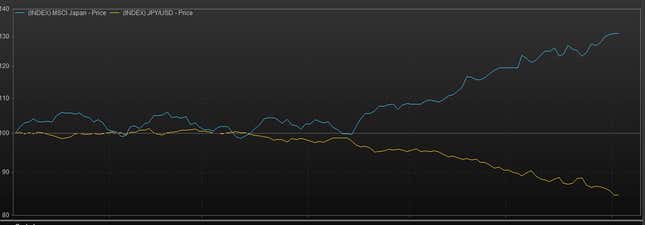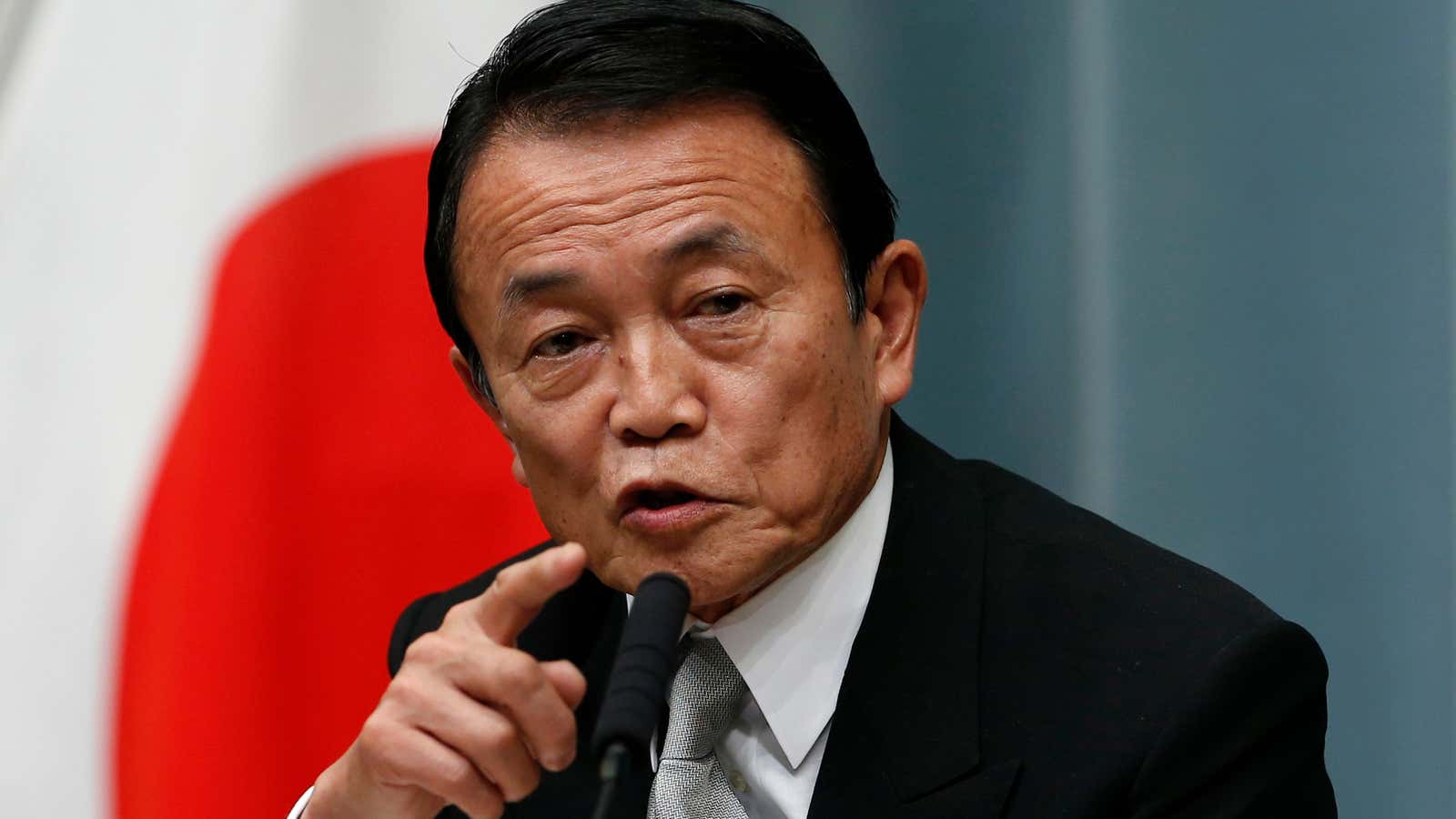Once-struggling Japanese electronics firm Panasonic has turned a corner. The company reported a swing back to profit, after posting a crushing loss this time last year. Its shares surged almost 17% on the news.
Panasonic’s turnaround and its shareholders’ improving fortunes are mostly thanks to Japan’s new prime minister Shinzo Abe’s promise to boost the economy by aggressively printing more yen. Speculators have pushed the yen down against the dollar since it became clear that Abe, who wants to print more cash to combat Japan’s persistent deflation, would win Japan’s general election last December 16.
Not only does the drastically weakened yen make Panasonic’s products cheaper abroad. It has also been great for Japanese stocks. Because of the program of fiscal and monetary stimulus that Japan market-watchers are calling “Abenomics,” punters are placing a twin-pronged bet that the weakening currency is good for exporters and that Abe’s money-printing scheme will boost Japan’s economy in the long run. Such is the received wisdom of this trade that shares of Sony Corporation jumped close to 8% on the back of Panasonic’s results, even though the main bit of recent news out of Sony is the lackluster story that it is developing a new Playstation in a world where smartphones are largely replacing games consoles anyway.
The chart below shows how, in the course of the last 12 months, the yen’s recent decline against the dollar (yellow line) mirrors a corresponding rise in shares of major Japanese companies (blue line):

But the problem with betting on Abenomics is that it hasn’t quite started yet—and there is no guarantee it will work. Japan’s finance minister Taro Aso—this is the man who just said Japan’s old people should “hurry up and die”—has claimed that the government is priming a fiscal stimulus that would echo the country’s massive spending policies of the 1930s. Yet the Bank of Japan, which holds the country’s purse strings, has not even decided whether to board the Abe train yet. With characteristic diplomacy, the central bank has broadly agreed to Abe’s 2% inflation target, but refused to set a time frame for achieving it. (That is the central banker’s version of saying vaguely to an acquaintance, “Let’s definitely have lunch. I’ll call you.”)
Meanwhile, Abenomics may also not work because its money-printing agenda does nothing to address Japan’s myriad structural problems. To recap: The country has a vast population of old people that need support; its car-makers are uncompetitive and lack a convincing strategy; its economy suffers from crony capitalism and banks keep well connected zombie companies alive at the expense of potentially exciting start-ups.
Bloomberg commentator William Pesek has a longer shopping list of problems Japan’s government needs to solve before the economy truly recovers. “Abe isn’t offering anything new,” he writes. “Aside from a weaker yen, does he have a plan to make Japan more competitive to take on China or halt Sony Corp.’s slide toward irrelevance? How about ideas to make the labor force more flexible and international, starting with a new immigration policy? Or a strategy that inspires young Japanese to start new companies or families? What about freer trade? Increasing women’s role in politics and business? Even an energy plan that champions something other than the nuclear reactors Japanese fear amid earthquake risks?”
London consultancy Capital Economics added another dimension of doubt in its January 30 note.
“Most commentators still appear to be taking Prime Minister Shinzo Abe’s promises to boost economic growth via powerful fiscal and monetary stimulus almost entirely at face value,” the consultancy wrote. But, it added, the market’s faith in Abenomics should evaporate by the middle of the year once investors realize the growth plans are probably not possible.
Japan’s new government has committed both to fiscal stimulus and to fiscal discipline, which is the politician’s version of promising the bank to rein in your overdraft while also promising your children expensive gifts. A few days ago, Abe’s administration unveiled a raft of savings, including deep cuts in education spending and government officials’ salaries.
“At best, this will dilute the impact of fiscal stimulus elsewhere,” Capital Economics wrote. “At worst, it will confuse the markets.”
In Japan, fiscal stimulus is also nothing new. Since World War II, says Capital Economics, Japanese governments have announced a round of pump-priming stimulus “at least once a year.” What is more, they say, we do not yet know “how much of the fiscal stimulus is genuinely new, rather than the announcement of spending that would have happened anyway.”
Investors love a good story. And with China’s vaunted recovery tailing off, the resurgence of Japan under a new leader determined to boost the long-ailing economy is a great one for professional fund managers who are switching funds out of China and need somewhere to park the cash. But the too-good-to-be-true nature of the Japanese government’s policies means the challenge will lie in hopping off the Abenomics wagon before markets realize that it is running out of gas.
